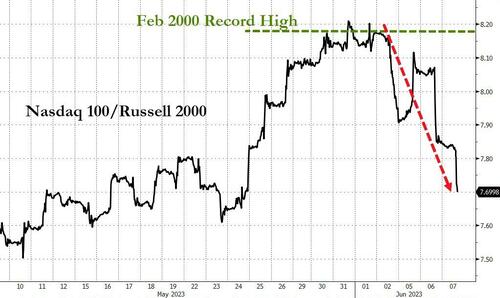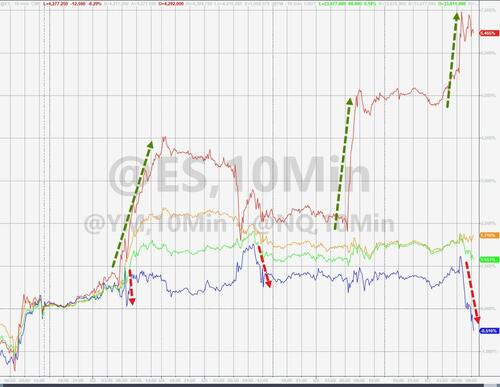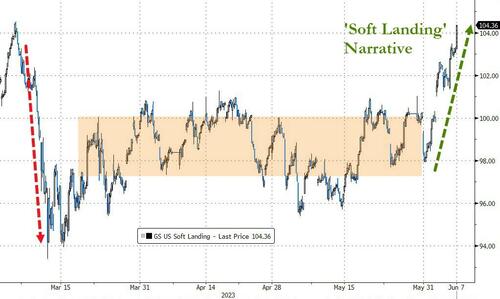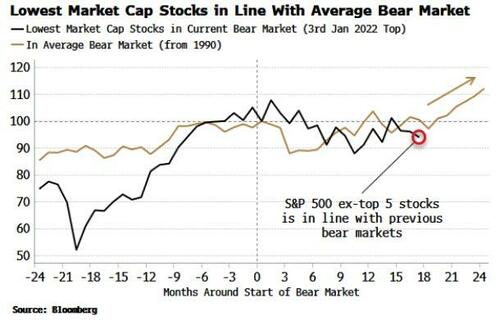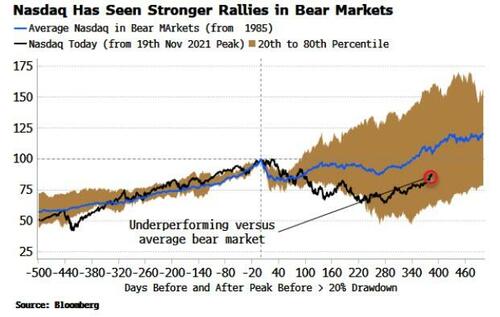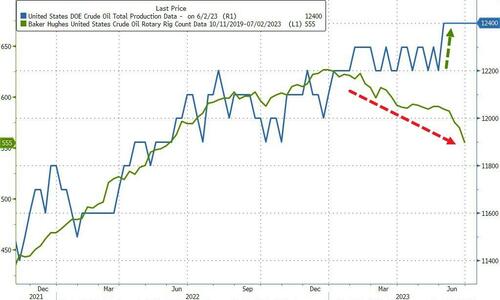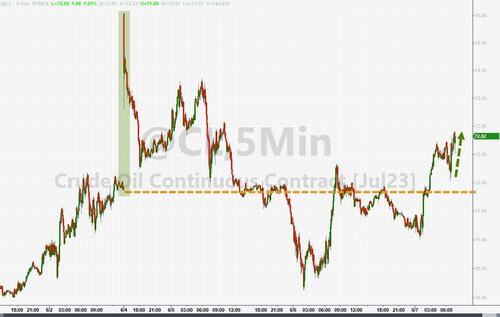Authored by James Rickards via DailyReckoning.com,
It looks like the much-anticipated Ukrainian spring offensive may finally be getting underway. Yesterday, Russia repelled Ukrainian attacks in five places.
It’s very early — these were likely probing attacks looking to detect weak points in Russian defensive positions — but these attacks were much heavier than previous probing attacks.
We’ll have to see what happens.
When the main offensive comes, it’s very possible that Ukrainian forces will break through in certain areas. They might capture some territory (with plenty of U.S./NATO-supplied reconnaissance and intelligence to assist them), but it’s unlikely that their gains will be sustainable.
The offensive will probably peter out as Russian forces gradually grind it down.
Russia has several defensive lines in the region, fortified by minefields, anti-tank ditches, concrete obstacles known as dragon’s teeth, etc. These are formidable defenses that Russia has spent several months creating.
If Ukraine breaks through one line, it’ll have to confront another. And another. And another one after that.
It’s also important to realize that offensives on the scale envisioned require massive logistical support, and it’s far from clear that Ukraine has the resources to sustain a major offensive. It doesn’t help that Russia has been steadily targeting Ukrainian ammunition depots, transportation links, marshaling points, etc.
Meanwhile, Zelensky wants more Patriot missile systems. That’s because the Russians have already destroyed one-third of the systems we sent.
As I’ve argued before, Russia is winning the war. The West can’t afford to give Ukraine much more weaponry, and support for the war effort is declining.

Negotiation or Escalation
All that remains is negotiation or escalation toward nuclear war. Unfortunately, Biden will probably choose to escalate.
First he said no tanks, then he agreed to send tanks. Then he said no F-16s, now he’s agreed to send F-16s. There’s no reason to believe it’ll end there. Biden’s in way too deep to just walk away at this point.
And there’s certainly no reason to believe that Biden will relent on the anti-Russian economic sanctions. In fact, even more sanctions are being imposed.
Here’s the latest sanctions announcement from the U.S. as reported by Stratfor recently:
The United States enacted new sanctions on 69 Russian entities, one Armenian entity and one Kyrgyz entity, as well as halted the export of a wide range of up to 1,200 additional products and consumer goods to Russia, Reuters reported on May 19. The new sanctions and restrictions are part of the United States’ realization of the Group of Seven’s recent statement on Ukraine declaring the group’s intent to expand sanctions on Russia.
The measures suggest greater emphasis on blocking those who circumvent or facilitate the circumvention of sanctions, but the sanctions are unlikely to stop the emergence of new circumvention schemes or impede Russia’s ability to continue the war in Ukraine. Still, they will create new compliance risks for companies across a range of sectors from consumer goods to high technology that now must ensure that their business activities do not run afoul of the new measures.
In April, the International Monetary Fund further improved its forecast for Russia’s economy, which it sees growing by 0.7% this year, up 0.4 percentage points from the January forecast.
The Failure of Sanctions
The starting place for analysis is to realize that these anti-Russian sanctions are unprecedented as to the scope and the number of entities affected. The U.S. has frozen the bank accounts of the Russian Central Bank and a long list of Russian companies. It has kicked Russia out of the global interbank message traffic system called SWIFT.
It’s not too much to call SWIFT the central nervous system of the global financial system. Banning Russia greatly impedes the ability of their banks to make payments even if they are using currencies other than the U.S. dollar and transacting with non-U.S. banks.
U.S. companies by the thousands have closed up shop in Russia. They have either shut down their operations or temporarily suspended them. U.S. persons are prohibited from making new investments in Russia under pain of severe fines or imprisonment.
Strategic metals exports from Russia have been banned in many cases. Imports to Russia of semiconductors and other high-tech outputs and equipment have been banned. Russian oil exports by tankers have been prohibited.
This oil ban has been backed up by a separate ban on cargo and vessel insurance from major providers such as Lloyd’s of London. Without insurance, most parties won’t ship or purchase the oil.
The list goes on. New targets and sanctions are being announced continually. What has been the result of this global financial sanctions war?
It has been a complete failure. Russia is clearly winning the kinetic war on the ground in Ukraine, and it’s winning the financial war as well.
This Wasn’t in the Playbook
The Russian ruble is as strong as it was before the Russian invasion. Biden’s claim that sanctions would “destroy” the ruble was just hot air. The Russian economy declined about 3% in 2022 after critics claimed it would crash by 10% or more.
This year, Russia is projected to grow 0.7% by the IMF at a time when many analysts expect the U.S. economy to fall into a severe recession.
Russia has easily been able to evade sanctions on oil exports by using a “ghost fleet” of vessels that turn off transponders and engage in ship-to-ship oil transfers to mask the identity of the seller at the port of discharge.
There’s nothing surprising about this. Mastermind commodity trader Marc Rich did the same thing to evade oil export sanctions on Iran and Iraq in the 1990s and 2000s from his chateau in Zug, Switzerland.
The insurance bans have also proved ineffective. There are easy workarounds including self-insurance, captive insurance companies, and insurance from companies that are not participating in the boycott.
More recently, the U.S. has imposed further sanctions on two major gold mining companies in Russia. This is nonsense put on for show. Gold is an element, atomic number 79. Once it is melted and recast into generic bars it is untraceable. It can be moved secretly around the world by air and sold in markets from Shanghai to Singapore.
Gold is gold and it will go where it wants. The U.S. sanctions will have no impact except to increase costs in global trade.
The Desperation of Secondary Boycotts
Indeed, many of the most important countries in the world are maintaining a neutral stance and are not supporting U.S. sanctions. These neutral parties include India, China, South Africa, and Brazil, which collectively include almost 40% of the earth’s population.
India, China and Brazil are three of the ten largest economies in the world and collectively produce 24% of global GDP.
What’s new about the recent sanctions report quoted above is the U.S. is now getting desperate about the failure of sanctions to damage Russia or change Russian behavior in Ukraine.
The U.S. has begun imposing what are called secondary boycotts. This means that the sanctions do not target Russia directly, but target countries that do business with Russia and do not follow U.S. orders.
For example, China is reported to be selling semiconductors to Russia even as Brazil sells aircraft and India sells drones. China and India also purchase oil from Russia. It is also reported that South Africa has begun weapons sales to Russia.
All of these sales are in violation of U.S. sanctions. Reportedly, the U.S. will begin imposing separate sanctions on China, Brazil, India, and South Africa for not adhering to U.S. sanctions.
How Does This End Well?
These new secondary boycott sanctions will not be well-received. China, Brazil, India, and South Africa will not passively absorb the secondary boycotts.
They will retaliate in their own way. The tit-for-tax sanctions will not impede Russia at all, but they will lead to a further contraction of world trade, something last seen during the Great Depression.
Biden claims that the sanctions will not end until Russia withdraws entirely from Ukraine, including Crimea. Not only will Russia not withdraw, it continues to make major military and territorial gains. A Ukrainian offensive won’t fundamentally change that reality, unless it somehow manages to overcome very long odds.
This means the sanctions will continue indefinitely.
It also means Biden has created a major drag on world trade on top of the other headwinds already facing the global economy.
Investors will be well-served by allocating assets toward cash, gold, and other hard assets. These will be the real winners as the war in Ukraine drags on.


